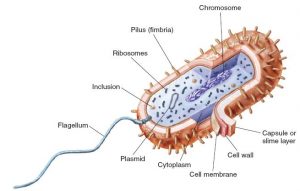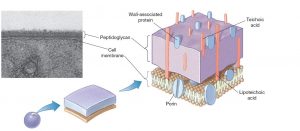Structure of Bacterial Cell, Prokaryotic Cells and MCQ for GPAT, NEET, CSIR NET JRF, SSC CGL Exam
BACTERIAL STRUCTURE
structure of a bacillus
The above image is taken only for educational purpose from Microbiology Principles and Explorations by Jaquelyn G. Black
- Cell wall:= Gram Positive Bacteria Cell Wall Structure
- It is present outside the cell of almost all the bacteria. It maintains the shape of cell and also prevents the cell from bursting due to endosmosis. It is porous and allows almost all materials into the cell. It is mainly made up of peptidoglycan. The thickness of peptidoglycan layers in different bacteria is the basis for distinguishing between gram-negative and gram-positive bacteria. In gram-negative bacteria, an additional outer membrane is present which is made of lipoprotein molecules. These outer membranes acts as coarse sieves and prevents entry of drugs like penicillin into the cells. Outer membrane also contains lipopolysaccharide, which is an endotoxin. These endotoxins are releases at the time of death of cells.
Gram Negative Bacteria Cell Wall Structure
- Characteristics and Differences between cell walls of gram-positive and gram-negative bacteria:
| GRAM-POSITIVE BACTERIA | GRAM-NEGATIVE BACTERIA |
| Thin layer of peptidoglycan | Thin layer of peptidoglycan |
| Teichoic acid present | Teichoic acid absent |
| Little amount of lipids are present | Lipopolysaccharides are present |
| Outer membrane is absent | Outer membrane is present |
| Periplasmic space is present | Periplasmicspace is absent |
| Always rigid cell shape | Cell shape may be rigid or flexible |
| Protoplast remains on digestion of cell wall by enzymes | Spheroplast remains on digestion of cell wall by the enzymes |
| Very sensitive to antibiotics and dyes | Less sensitive to antibiotics and dyes |
Cell
the above image is taken only for educational purpose from
Microbiology Principles and Explorations by Jaquelyn G. Black
 Cell wall of gram-negative bacteria
Cell wall of gram-negative bacteria
the above image is taken only for educational purpose from
Microbiology Principles and Explorations by Jaquelyn G. Black
- Periplasmic space: In many bacteria, there is a gap present between cell wall and cell membrane. It can be observed in the gram-negative bacteria under electron microscope. This space has many digestive enzymes and proteins which can destroy the harmful substances. In gram-positive bacteria, this space is rarely found. Periplasmic space is filled with periplasm, which consists of peptidoglycan, proteins and metabolites. In gram-positive bacteria, only periplasm attaches with cell wall is present.
- Cell membrane:
- It is a dynamic membrane made up of phospholipids and proteins. The structure is generally represented by fluid-mosaic model in which phospholipids are in fluid form and proteins are in dispersed form forming a mosaic pattern. Phospholipids forms a bilayer in which phosphate ends extends towards the membrane surface and fatty acid ends extends inwards. Phosphate ends are hydrophilic and thus they can better interact with the watery environment. fatty acids are hydrophobic, thus acts as a barrier between the cell and environment. In bacteria where cell wall is absent, sterols are present in the membranes which provides rigidity to the cell membrane. Some of the dispersed proteins extends from outside to inside of the cell membrane and acts as carriers or channels for other materials to enter into the cell. Cell membrane selectively allows the movement of particles in and out of the cell. In bacteria, along with this, cell membrane also takes part in DNA replication, ATP synthesis, respiration, formation of cell wall and secretion of proteins.
- Cytoplasm: It is the semifluid substance present inside the cell membrane. It mainly consists of water and having substances like enzymes, proteins, nutrients, etc. It is the site for anabolic and catabolic reactions.
- Ribosomes:
- These are spherical bodies present in the cell which is responsible for the synthesis of proteins. They are present in the form of chain known as polyribosomes. In bacteria, 70S type of ribosomes are present in which, larger subunit is of 50S and smaller is of 30S.
- Nuclear region:
- The genetic material in bacteria is not enclosed in membrane but is present in the nuclear region. Nuclear region mainly consists of DNA but have small presence of RNA and proteins.
- Flagella:
- Nearly half of the bacteria are motile due to presence of flagella. These are long, thin, helical appendages. When bacteria have single flagellum, the condition is called monotrichous; bacteria having one flagella at each end is called amphitrichous; bacteria having two or more than two flagella at one end or at both ends are called lophotrichous; those which have flagella all over the body is called peritrichous and those which does not have any flagella is called atrichous.
- Pili:
- It is the tiny projections at the surface of the bacteria which helps the bacteria for attcahement on the other surfaces. Pili is made of pilin protein. Two types of pili are present in bacteria: first one is conjugation/F pili/sex pili, which helps in attachment of two bacterial cells together during transfer of genetic materials. Second one is shorter in length and is known as attachment pili/fimbriea which are useful for the attachment of bacteria on different surfaces.
- Glycocalyx: all the polysaccharide containing substances which are present outside the cell wall are referred as glycocalyx. It may include capsule and slime layer.
MCQs
1. Cell of bacteria is made up of?
a. Hemicellulose
b. Peptidoglycan
c. Genetic materia
d. Cellulose
2. The gap between cell wall and cell membrane is called?
a. Priplasmic space
b. Matrix
c. Intercellular space
d. Cristea
3. Many ribosomes combine together to form a chain known as?
a. Multiribosome
b. Polyibosome
c. Periplasm
d. Nucleoid
4. Glycocalyx is made made up of?
a. Polysaccharide
b. Cellulose
c. Peptidoglycan
d. Pectin
5. Which of the following are characteristics of gram-positive bacteria?
I. Presence of tichoic acid
II. Presence of outer membrane
III. Periplasmic space present
IV. Formation of spheroplast on cell wall digestion
a. I, III
b. II, IV
c. I, IV
d. II, III
6. Correct sequence for True/False for the given statements can be?
- Periplasmic space is present both in gram-positive and gram-negative bacteria.
- Gram-positive bacteria are very sensitive to antibiotics and dyes
- Fimbriea is the structure which helps during transfer of genetic material from one bacteria to another.
- Mitochondria is filled with periplasm.
a. FTTT
b. FTFF
c. TTFT
d. FTFT
7. Which of the following statements are correct related with the cell membrane of prokaryotic cells.
I. Bilayered
II. It also takes part in ATP synthesis
III. Structure is represented by fluid-mosaic model
IV. Phosphate ends are Hydrophobic in nature.
a. I, II, III
b. I, IV
c. II, III
d. I, III
Participate in Online FREE GPAT TEST: CLICK HERE
Participate in Online FREE Pharmacist TEST: CLICK HERE
Participate in Online FREE Drug Inspector TEST: CLICK HERE
ANSWERS
1-b
2-a
3-b
4-a
5-a
6-b
7-a
RFERENCES
[1] Black JG, Black LJ. Microbiology: principles and explorations. John Wiley & Sons; 2018 Jan 4.
